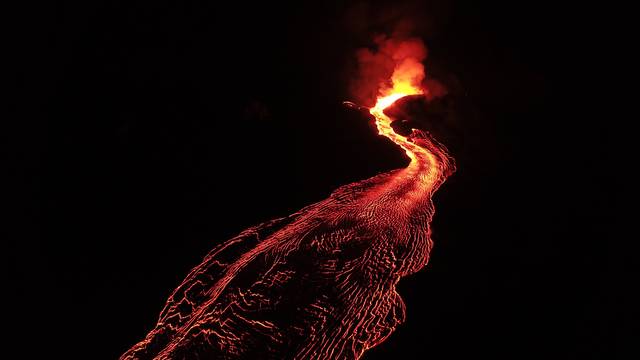Monday’s thunderstorm over the active lava fields in the lower East Rift Zone of Kilauea volcano produced about 1,200 lightning strikes between 7 a.m. and 4 p.m., according to the National Weather Service.
Janet Snyder, spokeswoman for Mayor Harry Kim, said Tuesday that the county “got calls galore from people” concerning the intense thunderstorm, which was centered largely over fissure 8 in Leilani Estates, with lightning strikes also occurring along the 8-mile-plus lava channel from the active fissure to the lava ocean entry at Kapoho.
“The volcano was definitely a major player in (Monday’s) weather,” said Robert Ballard, a meteorologist for the National Weather Service. “Seeing that is really unique for us, and we’re learning about how that’s going to have to change our forecast a little bit for that localized area.”
Ballard, who likened the thunderstorm to weather experienced near wildfires in the Western U.S., said while the intense heat from the lava played a major role in the thundershowers, there were “a couple of different things at play.”
“The other major player was an upper level low (pressure system) that was about 370 miles north of Hilo,” he said. “And south of the upper level low, it was dragging a pocket of cooler-than-normal air across the Big Island. That’s why we had thunderstorms not only over the lava field, we also had a couple of isolated thunderstorms on Maunakea. There was also one on the … slopes of Mauna Loa and even a brief one down in Ka‘u, as well.”
The storm clouds produced when factors such as those Ballard mentioned occur are called “pyrocumulus,” or “pyrocumulonimbus” clouds, he said.
The low pressure system has moved to the north and “pretty much out of our picture, now,” according to Ballard, who added another contributing factor to Monday’s unusual thunderstorm was moisture rising from the laze plume at the lava’s ocean entry point in Kapoho.
“We want people to be safe. Our rule of thumb is, if you can hear thunder, you’re close enough to be struck by lightning. And I think, even (Monday), that was the case. That doesn’t mean you’re definitely going to get hit, but you’re in a higher risk zone if you’re that close.”
Another lava-related phenomenon that has been documented in videos and photos recently are small whirlwinds that seem to emanate from the lava.
“These are not too dissimilar to waterspouts that we see at the base of cumulus clouds,” Ballard said. “Anytime you have a really strong updraft within the cloud, the air below it wants to pull inward. And it pulls inward … in a spiral, because it’s forming a weak, little low pressure area there. That’s how the whirlwind gets started. And once it gets started, it just feeds off the heat energy to sort of keep itself going and sustain itself.”
“This is not like a (tornado), but it is dangerous,” he added. “It can throw hot lava debris around.”
Email John Burnett at jburnett@hawaiitribune-herald.com






